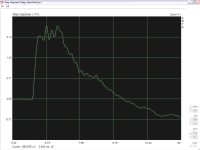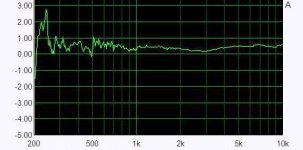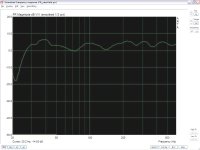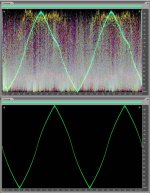I'm sorry, but this is completely incorrect. The off-axis radiation is perfectly correlated with the on-axis, and so your comment about the diffraction is also incorrect.
Would something like this create decorrelated reflections?
An externally hosted image should be here but it was not working when we last tested it.
It's a single box with 5" drivers on the left and right side, crossed over at 2.8kHz to a single tweeter.
Let the flame war begin 🙂
Its been too peacful around here - its time for a war.😉
Would something like this create decorrelated reflections?
It's a single box with 5" drivers on the left and right side, crossed over at 2.8kHz to a single tweeter.
Decorrelation is a matter of degree, actually a number betwee 0 (no correlation) and 1.0 (completely correlated. So yes that would tend to yield less correlation in the early sound field. but also less correlation in the direct field. Remember that what we want is a very high correlation of the direct sound with a rapidly falling correlation of the VER and reverberation.
But had they not been contra-lateral, but co-lateral would they have not been significantly worse? You cannot get rid of all early reflections in a small room without making it dead, but you can optimize the reflections to minimum effect. I think that we both do that.
Changed toe-in to 15°. Imaging is better. I also never liked the axis-crossing-before-listener-effect. I need the audible confirmation of the sweet-spot-lock-in-effect when my head is at the correct location.
I, for one, do not tweak any of my designs by "listening". It's an absurd practice that requires a real arrogance on the part of the designer to believe that his ears are better than his measurements. This would only be true for designers who were not competent at making the measurements.
OK, I'll engage in the battle.
I've heard plenty of the "paint by numbers" speakers, the computer designed crossovers, the "lack of a good ear" speakers. You can have them. I don't want them. Sure, they sound "OK", but never great. They sound to me like the designer did not know what he was doing - just stabbing at it with numbers. When a designer really understands speaker, and especially crossover design, you can hear it. There are lots of trade offs and balancing acts needed to achieve superior results.
FWIW, I have measured speakers that were designed and tweaked completely by ear and the measurements at the listening position would make most designers jealous. The sounded great too. I've also seen measurements of "scientific" speakers at the listening position. Not always pretty. Very "Hi-Fi", but not much like real music.
Bottom line. For me, it does not matter HOW the designer got there, as long as it sounds right. By ear, by computer, by Ouija board - it's the results that matter. Some have talent, some don't. But the best I've heard were done by designers who actually listen to them.
And some of the worst, too. 😉
I'm sorry, but this is completely incorrect. The off-axis radiation is perfectly correlated with the on-axis, and so your comment about the diffraction is also incorrect.
With "a speaker radiating off axis in a diffuse manner"
i did not mean usual pistonic speakers to do so ...
It is correct for panel form bending wave transducers
i referred to.
FWIW, I have measured speakers that were designed and tweaked completely by ear and the measurements at the listening position would make most designers jealous. The sounded great too. I've also seen measurements of "scientific" speakers at the listening position. Not always pretty. Very "Hi-Fi", but not much like real music.
Then obviously the measurements that you took are not the whole story or this would not be the case. Everything that I have heard and measured completly confirm my poiint of view. As we have talked about in this thread over and over again, there is no single in-room measurement of the sound that is going to correlate with perception. But there are a range of measurements that do. And don't ask "What are they" because that question has already been answer numerous times.
According to Sean Olive his measurements correlate to perception at about 95% confidence. I have some issues with what he has done and his claims, but they are not major objections. I believe that such a thing is possible. I believe that I do it.
With "a speaker radiating off axis in a diffuse manner"
i did not mean usual pistonic speakers to do so ...
It is correct for panel form bending wave transducers
i referred to.
I see what you meant, but it was not clear at first. As I said, a decorrelated direct field is not what we want. And yes, bending wave transducers do not have very good imaging.
lol There is. Binaural impulse response with dummy head + pinna + torso. You can use your own head with in ear microphones.
That is all there is to measure 😉
- Elias
That is all there is to measure 😉
- Elias
there is no single in-room measurement of the sound that is going to correlate with perception.
The high modal density of a panel bending wave device does cause the radiation to be less correlated than a piston source. But this is NOT what we want. We want a highly correlated and coherent direct sound, just not a correalted reverb field. When the direct field is decorrelated between two sources (say stereo), then all imaging information in the recording is lost. There is no image possible.
...
In a well designed panel form bending wave transducer
neither the on axis sound is decorrelated with
the input signal nor is there a decorrelation
between left and right loudspeaker introduced
on axis. That would only occur with production
tolerances too high, like in any other speaker concept ...
There is just a gradual decorrelation, increasing smoothly
with off axis angle. An ideal behaviour for stable imageing
even in far from ideal rooms.
Overall quality in most of the current designs is still
rather poor nevertheless. Bandwitdh, transient response,
smoothness of frequency response are far from ideal with
most designs.
But these drawbacks are not inherent to the principle.
They are consequences of half hearted design and
flawed implementation detail mostly.
Your thoughts on proper imageing being impossible
with that concept may be based either on theoretical
assumptions contradicting from your point of view or
maybe you had also poor listening experiences with
some mediocre designs.
Nevertheless i have to dispel your concerns by own
experience.
And i do not believe, that you had the opportunity to
audition bending wave's that do things similar to that:
Step Response, Group Delay, LF Nearfield Response
Attachments
Last edited:
Decorrelation is a matter of degree, actually a number betwee 0 (no correlation) and 1.0 (completely correlated. So yes that would tend to yield less correlation in the early sound field. but also less correlation in the direct field. Remember that what we want is a very high correlation of the direct sound with a rapidly falling correlation of the VER and reverberation.
Please define "decorrelated direct field".
I've been struggling to understand the correlated/uncorrelated information. Seems to me it can be best understood in terms of cues.
Correlated sounds make the image of the driver coherent, like any real sound source and so your mind creates a stable and correct image of the source - in this case, the driver. And, that is not conducive to the illusory perception we want to create.
Uncorrelated sound does not support the creation in your mind of a stable and coherent perception of anything. But it does provide weak cues that the source is a large hall. The brain uses any cues it can get its ears on because the brain is constantly striving to create stable perceptions... that's what brains do. And so it forms, in Helmholtzian fashion, a perception of a largish space (AKA ambiance).
At the same time, the brain is cobbling together whatever other cues (inter-ear differences, timing, echos, stereo-geometrical cues, equal loudness contour position, all kinds of cues, etc.) to form an aural image... which recording engineers hope bears a resemblance to the orchestra (real or purely synthesized) they are trying to present to the listener. *
The theory works for me.
*Hint, if an engineer wanted his/her listeners to have EXCELLENT stereo with perfect height and depth perception, all they have to do is supply a photo of the orchestra in the album. Then you'd "hear" the orchestra really well.
Correlated sounds make the image of the driver coherent, like any real sound source and so your mind creates a stable and correct image of the source - in this case, the driver. And, that is not conducive to the illusory perception we want to create.
Uncorrelated sound does not support the creation in your mind of a stable and coherent perception of anything. But it does provide weak cues that the source is a large hall. The brain uses any cues it can get its ears on because the brain is constantly striving to create stable perceptions... that's what brains do. And so it forms, in Helmholtzian fashion, a perception of a largish space (AKA ambiance).
At the same time, the brain is cobbling together whatever other cues (inter-ear differences, timing, echos, stereo-geometrical cues, equal loudness contour position, all kinds of cues, etc.) to form an aural image... which recording engineers hope bears a resemblance to the orchestra (real or purely synthesized) they are trying to present to the listener. *
The theory works for me.
*Hint, if an engineer wanted his/her listeners to have EXCELLENT stereo with perfect height and depth perception, all they have to do is supply a photo of the orchestra in the album. Then you'd "hear" the orchestra really well.
Last edited:
The theory works for me.
I'd say that theory is wrong and not in agreement with what Kendall wrote in the paper that was linked earlier or I don't understand what you've said.
Last edited:
Please allow me a short comment on post #1010:
I usually do not like to post such preliminary results,
as they are still flawed. The step response shows some
ringing around 5Khz, this is partly due do the panel
held in a test frame with exciter having only a preliminary
bonding (which is more massive than the final glue), also
explaining the poor rise of the step.
But i guess from the falling slope of the step, the flat
group delay (which is virtually within the IRT Munich
recommendation for future monitor speakers of +/- 0.2ms
from 500Hz...10Khz without any compensation applied)
and the lower cuttoff frequency around 27Hz, you may see
that not all bending wave transducers are created equal ...
I usually do not like to post such preliminary results,
as they are still flawed. The step response shows some
ringing around 5Khz, this is partly due do the panel
held in a test frame with exciter having only a preliminary
bonding (which is more massive than the final glue), also
explaining the poor rise of the step.
But i guess from the falling slope of the step, the flat
group delay (which is virtually within the IRT Munich
recommendation for future monitor speakers of +/- 0.2ms
from 500Hz...10Khz without any compensation applied)
and the lower cuttoff frequency around 27Hz, you may see
that not all bending wave transducers are created equal ...
Last edited:
Hello,
Elias does this makes sense to you ?
It's not an impulse, but a binaural test showing the panoramic phase of a
1000 Hz sinus with a stereo field rotation of 180°, vs the recorded one.
The mikes where almost at the inter aural spacing: 17.2 cm, e.g. wavelength 1000 Hz/4 😉.
and 5 meters from the speakers that were in side firing configuration.
Elias does this makes sense to you ?
It's not an impulse, but a binaural test showing the panoramic phase of a
1000 Hz sinus with a stereo field rotation of 180°, vs the recorded one.
The mikes where almost at the inter aural spacing: 17.2 cm, e.g. wavelength 1000 Hz/4 😉.
and 5 meters from the speakers that were in side firing configuration.
Attachments
In a well designed panel form bending wave transducer
neither the on axis sound is decorrelated with
the input signal nor is there a decorrelation
between left and right loudspeaker introduced
on axis. That would only occur with production
tolerances too high, like in any other speaker concept ...
There is just a gradual decorrelation, increasing smoothly
with off axis angle. An ideal behaviour for stable imageing
even in far from ideal rooms.
I'm sorry but this doesn't make much sense. How does the panel know what you have decided is "on-axis" - this exceedingly unique direction where all the sound is correlated while every other direction uncorrelated? Sorry, but thats not good physics.
...
How does the panel know what you have decided is "on-axis"
...
Like any other speaker Dr. Geddes - by directing them
fairly symmetrical at the listener.
Please define "decorrelated direct field".
If there is a random nature to the phase of the signal relative to the input signal then this would be "decorrelated". The high modal density within the transducer itself tends to introduce this phase randomness even if the amplitude response is fairly uniform. This is entirely comparable to the situation in a room where the sound field after a number of reflections becomes uncorrelated - its the modal density that does this. A panel radiator source sets off a plethora of modes which creates some randomness and decorrelation in the sound field that results. But contrary to some other opinions, this happens at all points in the sound field not just off axis points. I see no physical way that it could be correlated on-axis but decorrelated off-axis. I can see how the correlation would fall as the signal level fell off axis because there is both a correalted and a decorrelated portion of the field. If the correlated falls off and the decorrelated does not then the total correlation would fall. But there would always be some contribution of the decorrelated field at all points in space.
A light bulb is decorrelated light and radiates in all directions as a result. A laser is perfectly correlated light and radiates in a single direction, again as a direct result of the fact that its waveform is completly coherent.
Like any other speaker Dr. Geddes - by directing them
fairly symmetrical at the listener.
So on-axis is wherever the listener sits? And the wave in this direction arranges itself to be correlated? And what happens if we turn the source? The transducer readjusts itself?
I've been struggling to understand the correlated/uncorrelated information. Seems to me it can be best understood in terms of cues.
You are mixing subjective with objective. The terms correlate/decorrelate are purely objective. While there can be and certainly are relationships between the subject perception and these objective measures, this correlation is not well established (except in perhaps the IACC aspect of spaciousness) so it might be persumptive to draw any conclusions about the subjective aspects. That the direct field should be correlated for good imaging seems to be fairly obvious from the fact that if you decorrelate the two stereo channels than all phase information is lost and any phase or timing information between the two channels is likewise lost. This would clearly prevent a stable central image, although such techniques are often used in recording to completly obscure the sound image.
- Status
- Not open for further replies.
- Home
- Loudspeakers
- Multi-Way
- 'Flat' is not correct for a stereo system ?



